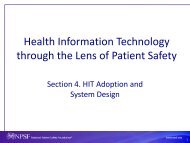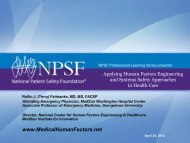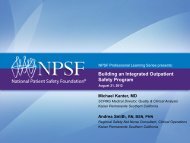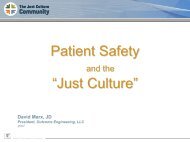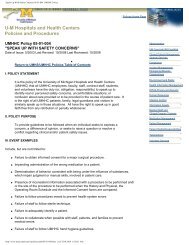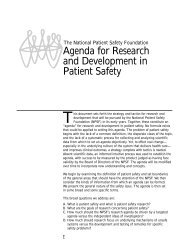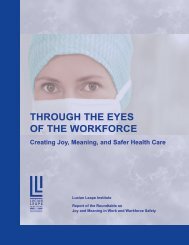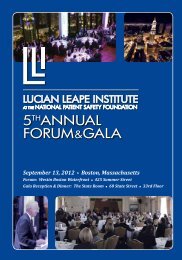Balancing Systems and Individual Accountability in a Safety Culture
Balancing Systems and Individual Accountability in a Safety Culture
Balancing Systems and Individual Accountability in a Safety Culture
Create successful ePaper yourself
Turn your PDF publications into a flip-book with our unique Google optimized e-Paper software.
Consider a Case• The ED was busy. The trauma service was treat<strong>in</strong>gother victims of the MVC.• Policy directs personnel to confirm two identifiersbefore adm<strong>in</strong>ister<strong>in</strong>g blood products. After a “closecall” a year earlier, all ED <strong>and</strong> operat<strong>in</strong>g room (OR)personnel were retra<strong>in</strong>ed.Hickson GB et al. <strong>Balanc<strong>in</strong>g</strong> <strong>Systems</strong> <strong>and</strong> <strong>Individual</strong> <strong>Accountability</strong> <strong>in</strong> a <strong>Safety</strong> <strong>Culture</strong>. In S Berman (Ed).From Front Office to Front L<strong>in</strong>e: Essential Issues for Health Care Leaders, 2nd edn. Chicago: JCRI, <strong>in</strong> press.4NPSF Professional Learn<strong>in</strong>g Series
Consider a Case• Quality <strong>and</strong> risk teams will review records <strong>and</strong> schedule<strong>in</strong>terviews.• Policy directs a root cause analysis (RCA) to beattended by <strong>in</strong>volved personnel.• Other thoughts:• “I wonder what has been shared with the family.”• You also th<strong>in</strong>k about your team—nurses, physicians, or others—who are <strong>in</strong>volved• You make a mental note to alert the wellness program directorHickson GB et al. <strong>Balanc<strong>in</strong>g</strong> <strong>Systems</strong> <strong>and</strong> <strong>Individual</strong> <strong>Accountability</strong> <strong>in</strong> a <strong>Safety</strong> <strong>Culture</strong>. In S Berman (Ed).From Front Office to Front L<strong>in</strong>e: Essential Issues for Health Care Leaders, 2nd edn. Chicago: JCRI, <strong>in</strong> press.5NPSF Professional Learn<strong>in</strong>g Series
But how do we prevent…?6NPSF Professional Learn<strong>in</strong>g Series
But how do we prevent…?• Hospitals <strong>and</strong> medical groups are highly complex.• Humans are complex <strong>and</strong> subject to….• <strong>Balanc<strong>in</strong>g</strong> systems <strong>and</strong> <strong>in</strong>dividual accountability iscentral to the operations of a safety culture.Hickson GB et al. <strong>Balanc<strong>in</strong>g</strong> <strong>Systems</strong> <strong>and</strong> <strong>Individual</strong> <strong>Accountability</strong> <strong>in</strong> a <strong>Safety</strong> <strong>Culture</strong>. In S Berman (Ed).From Front Office to Front L<strong>in</strong>e: Essential Issues for Health Care Leaders, 2nd edn. Chicago: JCRI, <strong>in</strong> press.7NPSF Professional Learn<strong>in</strong>g Series
<strong>Accountability</strong>“<strong>Systems</strong>”“Human”8NPSF Professional Learn<strong>in</strong>g Series
But there is hope…• Baptist Memorial Hospital–Desoto (MS) IHI’s IMPACTICU collaborative• Infection rates fell• VAP (7.5 to 3.2 per 1,000 ventilator days)• BSIs (5.9 to 3.1 per 1,000 l<strong>in</strong>e days)*• The Michigan Health & Hospital Association (MHA)Keystone ICU project• 60% reduction <strong>in</strong> CLABSIs• Susta<strong>in</strong>ed at 36 months post-implementation of <strong>in</strong>terventions***Ja<strong>in</strong> M et al.: Decl<strong>in</strong>e <strong>in</strong> ICU adverse events, nosocomial <strong>in</strong>fections <strong>and</strong> cost through a quality improvement <strong>in</strong>itiativefocus<strong>in</strong>g on teamwork <strong>and</strong> culture change. Qual Saf Health Care 15:235–239, Aug. 2006.**Pronovost PJ et al. Susta<strong>in</strong><strong>in</strong>g reductions <strong>in</strong> catheter related bloodstream <strong>in</strong>fections <strong>in</strong> Michigan <strong>in</strong>tensive care units:Observational study. BMJ 340:c309, Feb. 2010.9NPSF Professional Learn<strong>in</strong>g Series
But there is hope…• Elements that promote success <strong>in</strong> pursuit of safety:1. Clear leadership commitment2. Articulated goals3. Changes <strong>in</strong> work patterns to create teams that communicate <strong>and</strong>participate <strong>in</strong> decision mak<strong>in</strong>g4. Elim<strong>in</strong>ation of unnecessary variation5. Measures for track<strong>in</strong>g progress <strong>and</strong> provid<strong>in</strong>g feedback6. Stepwise, graduated <strong>in</strong>terventions for personnel exhibit<strong>in</strong>gnon-teamwork-promot<strong>in</strong>g (disruptive) behaviorHickson GB et al. <strong>Balanc<strong>in</strong>g</strong> <strong>Systems</strong> <strong>and</strong> <strong>Individual</strong> <strong>Accountability</strong> <strong>in</strong> a <strong>Safety</strong> <strong>Culture</strong>. In S Berman (Ed).From Front Office to Front L<strong>in</strong>e: Essential Issues for Health Care Leaders, 2nd edn. Chicago: JCRI, <strong>in</strong> press.10NPSF Professional Learn<strong>in</strong>g Series
Pursuit of <strong>Safety</strong>• Four foundational elements:• Shared values <strong>and</strong> goals• Effective leadership• Teamwork• <strong>Safety</strong> culture• All affirm <strong>and</strong> mutually re<strong>in</strong>force tomake health care saferHickson GB et al. <strong>Balanc<strong>in</strong>g</strong> <strong>Systems</strong> <strong>and</strong> <strong>Individual</strong> <strong>Accountability</strong> <strong>in</strong> a <strong>Safety</strong> <strong>Culture</strong>. In S Berman (Ed).From Front Office to Front L<strong>in</strong>e: Essential Issues for Health Care Leaders, 2nd edn. Chicago: JCRI, <strong>in</strong> press.11NPSF Professional Learn<strong>in</strong>g Series
What are the prerequisites?• Shared values <strong>and</strong> goals for team members (all)Credo• I make those I serve my highest priority.• I communicate effectively.• I conduct myself professionally.• I respect privacy <strong>and</strong> confidentiality.• I have a sense of ownership.• I am committed to my colleagues.Hickson GB et al. <strong>Balanc<strong>in</strong>g</strong> <strong>Systems</strong> <strong>and</strong> <strong>Individual</strong> <strong>Accountability</strong> <strong>in</strong> a <strong>Safety</strong> <strong>Culture</strong>. In S Berman (Ed).From Front Office to Front L<strong>in</strong>e: Essential Issues for Health Care Leaders, 2nd edn. Chicago: JCRI, <strong>in</strong> press.12NPSF Professional Learn<strong>in</strong>g Series
What are the prerequisites?• Clear Leadership Commitment (modeled)• Authority derives from their organization role, policy directives, <strong>and</strong>hospital <strong>and</strong> medical staff bylaws, as reflected <strong>in</strong> accreditationst<strong>and</strong>ards.• Leaders underst<strong>and</strong> mission <strong>and</strong> credo.• Leaders establish (<strong>and</strong> follow) processes that are transparent <strong>and</strong>data driven.• Leaders underst<strong>and</strong> their own accountability.• Leaders will not “bl<strong>in</strong>k.”Hickson GB et al. <strong>Balanc<strong>in</strong>g</strong> <strong>Systems</strong> <strong>and</strong> <strong>Individual</strong> <strong>Accountability</strong> <strong>in</strong> a <strong>Safety</strong> <strong>Culture</strong>. In S Berman (Ed).From Front Office to Front L<strong>in</strong>e: Essential Issues for Health Care Leaders, 2nd edn. Chicago: JCRI, <strong>in</strong> press.13NPSF Professional Learn<strong>in</strong>g Series
Values <strong>and</strong> leadership (modeled)allow “teams” to flourish.14NPSF Professional Learn<strong>in</strong>g Series
How do you know (or do you know)when an event (or near miss) occurs?Will team members report?15NPSF Professional Learn<strong>in</strong>g Series
Our team members feel free toreport or refer DB40%1. Strongly agree2. Agree3. Uncerta<strong>in</strong>4. Disagree5. Strongly disagree5%20%26%9%1 2 3 4 516NPSF Professional Learn<strong>in</strong>g Series
Team members will report if:• There is psychological safety• There is a belief that the organization will review<strong>and</strong> act to address both unsafe systems <strong>and</strong>non-teamwork-promot<strong>in</strong>g (disruptive) behaviorHickson GB et al. <strong>Balanc<strong>in</strong>g</strong> <strong>Systems</strong> <strong>and</strong> <strong>Individual</strong> <strong>Accountability</strong> <strong>in</strong> a <strong>Safety</strong> <strong>Culture</strong>. In S Berman (Ed).From Front Office to Front L<strong>in</strong>e: Essential Issues for Health Care Leaders, 2nd edn. Chicago: JCRI, <strong>in</strong> press.17NPSF Professional Learn<strong>in</strong>g Series
What are the prerequisites?• Surveillance systems• Executive walk-arounds allow leaders to visit…observe, listen <strong>and</strong>ask questions that elicit <strong>in</strong>formation about events or near misses,concerns about safety*• Team member reports – <strong>in</strong>cidents, events, near misses,unprofessional behavior, observed or suspected violations ofregulatory requirements (privacy, unethical or improper conduct),harassment or discrim<strong>in</strong>ation compla<strong>in</strong>ts, unsafe equipment <strong>and</strong>medications, equipment/product recalls*Frankel A et al. Patient safety leadership walkrounds. Jt Comm J Qual Saf 29:16–26, Jan. 2003.18NPSF Professional Learn<strong>in</strong>g Series
What are the prerequisites?• Surveillance systems cont<strong>in</strong>ued• <strong>Safety</strong> culture surveys• Unsolicited patient/family compla<strong>in</strong>ts*• Trigger tools (systematic review of patient charts to f<strong>in</strong>dmarkers that can identify harm)***Institute for Healthcare Improvement: IHI GlobalTrigger Tool Guide. Dec. 2006. http://www.unmc.edu/rural/patient-safety/tooltime/TT13-040207-5MillionLives/IHIGlobalTriggerToolGuideDec06.pdf (accessed July 15, 2011).** Hayden AC et al. Best practices <strong>and</strong> advanced skills <strong>in</strong> healthcare service recovery programs. Jt Comm J Qual Saf.36(7):310–318. July 2010.19NPSF Professional Learn<strong>in</strong>g Series
Morbidity, Mortality &Improvement ConferenceMonroe Carell Jr. Children’s Hospital at V<strong>and</strong>erbilt[Date]Dies JN, Smith KM, Warren MD, et al. Transform<strong>in</strong>g the morbidity <strong>and</strong> mortality conference <strong>in</strong>to an <strong>in</strong>strument forsystem wide improvement. AHRQ: http://www.ahrq.gov/downloads/pub/advances2/vol2/Advances-Deis_82.pdf.(accessed Sept. 9, 2011).21NPSF Professional Learn<strong>in</strong>g Series
MM&I = M+M & ImprovementThe discussions <strong>in</strong> this conference areFOR QUALITY IMPROVEMENT/ PEER REVIEW PURPOSES ONLYFor the purposes of M+M & Improvement, an error is def<strong>in</strong>ed as:“an occasion <strong>in</strong> which a planned sequence of mental or physicalactivities fails to achieve its <strong>in</strong>tended outcome.”What is said here…stays here!Reason JT. Human error. NY: Cambridge University Press, 1990.22NPSF Professional Learn<strong>in</strong>g Series
Issues IdentifiedPEOPLEENVIRONMENTWorkloadExperience levelLack of agreement among healthcareteam re goals of treatmentMultiple services/consultantsFailure to recognize chang<strong>in</strong>gcl<strong>in</strong>ical status or vital signsOverflow policy not followedLack of awareness of back-upProcesses for “off” hours<strong>and</strong> downtimesIncomplete or lackof “sign-out”InconsistentreassessmentFloor team not aware ofpatient’s admissionLack of reassessmentNot always clear when patient“leaves our space”;who is responsible for the patient?Busy Friday nightShift changeIncorrect patientplacement based on present<strong>in</strong>gphysical examICU bed availabilityPerceived different level of cl<strong>in</strong>ical ancillarysupport available “day” versus “night”Incomplete documentationIncomplete exchange ofcl<strong>in</strong>ical <strong>in</strong>formationKey cl<strong>in</strong>ical <strong>in</strong>formation notavailable or communicatedTimes not documentedconsistentlyPatient/familycomplianceIncompletehistory givenby parentDelay <strong>in</strong> familyacceptanceof cl<strong>in</strong>ical<strong>in</strong>formationAdverse Outcome/“Near Miss”POLICY/PROCEDURECommunication/DocumentationOTHERKaoru Ishikawa, 199023NPSF Professional Learn<strong>in</strong>g Series
Work<strong>in</strong>g Action PlanWHAT WHO WHENSTATUSas of Jan. 2006ED to FloorCommunicationDr. XX– Pediatric Chief ResidentDr. YY– Pediatric Chief ResidentOct. 2005CompletedSBAR - Internal TransferCommunicationZZ– VCH PM&IDr. XX– Pediatric Chief ResidentDec. 2005CompletedCl<strong>in</strong>ical SupportTurn-Around TimesAA– VCH Adm<strong>in</strong>istration Nov. 2005 CompletedRapid Response TeamDr. BB– Chief of StaffCC– VCH Adm<strong>in</strong>istrationDD– Manager, PCCUNov. 2005ActivePhysician “sign-out”<strong>and</strong> TransferCommunicationDr. EE– Pediatric SurgeryDr. XX– Pediatric Chief ResidentDr. YY– Pediatric Chief ResidentNov. 2005Partiallyimplemented(Pediatric Medic<strong>in</strong>e)24NPSF Professional Learn<strong>in</strong>g Series
What are the prerequisites?• Resources• Funds to support dedicated personnel• Costs of tra<strong>in</strong><strong>in</strong>g leaders• Costs of surveillance systems for monitor<strong>in</strong>g performance• Informatics <strong>and</strong>/or biostatistics support• Consultations with mechanical <strong>and</strong> human factors eng<strong>in</strong>eers• Methodology for assess<strong>in</strong>g f<strong>in</strong>ancial implications related to returnon <strong>in</strong>vestment <strong>and</strong> value-based purchas<strong>in</strong>gHickson GB et al. <strong>Balanc<strong>in</strong>g</strong> <strong>Systems</strong> <strong>and</strong> <strong>Individual</strong> <strong>Accountability</strong> <strong>in</strong> a <strong>Safety</strong> <strong>Culture</strong>. In S Berman (Ed).From Front Office to Front L<strong>in</strong>e: Essential Issues for Health Care Leaders, 2nd edn. Chicago: JCRI, <strong>in</strong> press.25NPSF Professional Learn<strong>in</strong>g Series
Reason’s “Unsafe Acts”Algorithm (1997):• Did the team member <strong>in</strong>tend to cause harm?• Did the team member come to work impaired?• Did the team member know<strong>in</strong>gly <strong>and</strong> unreasonably<strong>in</strong>crease risk?• Would another team member <strong>in</strong> the same situationact <strong>in</strong> a similar manner?Reason JT. Manag<strong>in</strong>g the Risks of Organizational Accidents. Aldershot, UK: Ashgate Publish<strong>in</strong>g, 1997.26NPSF Professional Learn<strong>in</strong>g Series
<strong>Accountability</strong> PyramidAdapted from Hickson• GB, Pichert JW, Webb LE,Gabbe SG. Acad Med.Nov, 2007.No∆PatternpersistsApparentpatternS<strong>in</strong>gle“unprofessional"<strong>in</strong>cidents (merit?)Level 3 "Discipl<strong>in</strong>ary"InterventionVast majority of professionals - no issues -provide feedback on progressLevel 2 “Guided"Intervention by AuthorityLevel 1 "Awareness"InterventionM<strong>and</strong>atedM<strong>and</strong>ated Reviews"Informal" Cupof CoffeeIntervention27NPSF Professional Learn<strong>in</strong>g Series
But does an accountabilitypyramid really work?Yes, if leaders follow theprocess <strong>and</strong> don’t “bl<strong>in</strong>k.”28NPSF Professional Learn<strong>in</strong>g Series
Patient Compla<strong>in</strong>ts• “Dr. __ told us he was very busy <strong>and</strong> could not bespread any th<strong>in</strong>ner, <strong>and</strong> that we did not appreciate thedepth of his expertise.”• “Dr. ___ is either too busy or scatterbra<strong>in</strong>ed to read myfiles or is dangerously neglectful.... I fear for my safety<strong>and</strong> for her other patients....”• “Dr. __ <strong>in</strong>serted a dra<strong>in</strong> <strong>and</strong> walked out of the room.After a while another MD removed the dra<strong>in</strong> <strong>and</strong>expla<strong>in</strong>ed it wasn’t even <strong>in</strong> the cyst.”29NPSF Professional Learn<strong>in</strong>g Series
Academic vs. Community Medical Center% of Concerns100755025035–50% of physicians associated with NO concerns50% of concerns associated with 9–14% of physiciansAcademic Med CtrCommunity Med Ctr30 40 50 60 70 80 90 100% of PhysiciansHickson GB et al. SMJ. 2007; Hickson GB et al. JAMA. 2002 June 12;287(22):2951–2957.30NPSF Professional Learn<strong>in</strong>g Series
<strong>Accountability</strong> PyramidAdapted from HicksonGB, Pichert JW, Webb LE,Gabbe SG. Acad Med.Nov, 2007.No∆PatternpersistsApparentpatternS<strong>in</strong>gle“unprofessional"<strong>in</strong>cidents (merit?)Level 3 "Discipl<strong>in</strong>ary"InterventionLevel 2 “Guided"Intervention by AuthorityLevel 1 "Awareness"InterventionM<strong>and</strong>atedVast majority of professionals - no issues -provide feedback on progressM<strong>and</strong>ated Reviews"Informal" Cupof CoffeeIntervention31NPSF Professional Learn<strong>in</strong>g Series
Intervention on Dr. __• Letter with st<strong>and</strong><strong>in</strong>gs,assurances prior to <strong>and</strong> at meet<strong>in</strong>g• “You are here” graph with4-yr Risk ScoresFrequency of Risk Scores for Your Institution’s PhysiciansThis graph shows the distribution of physician Risk Scores. The Risk Score isbased on an algorithm <strong>in</strong> which compla<strong>in</strong>ts about physicians filed <strong>in</strong> more recentyears have greater impact than those from previous years.YourRiskScore• Compla<strong>in</strong>t Type Summary• “Concerns” bullet list• Redacted narrative reports32NPSF Professional Learn<strong>in</strong>g Series
PARS ® Progress ReportTotal # of high-compla<strong>in</strong>t physicians 723Departed after <strong>in</strong>itial <strong>in</strong>tervention 48First follow-up later <strong>in</strong> ’11 –’12 130Total with follow-up results 545Results for those with follow-up data:Good – Intervention visits suspended 262 48%Good – Anticipate suspension <strong>in</strong> ’11-’12 95 17%Some improvement – Still need track<strong>in</strong>g 31 6%Subtotal 388 71%Unimproved/worse 115 21%Departed Unimproved 42 8%Total follow-up results 54533NPSF Professional Learn<strong>in</strong>g Series
Back to the case• The RCA revealed:• The <strong>in</strong>compatible units were <strong>in</strong>tended for a second victim.• Dur<strong>in</strong>g the frenzy of activity, a nurse was dispatched fortrauma blood.• By chance, he pulled two units <strong>in</strong>tended for another patient(E-admitt<strong>in</strong>g system did not “talk” to lab system).Hickson GB et al. <strong>Balanc<strong>in</strong>g</strong> <strong>Systems</strong> <strong>and</strong> <strong>Individual</strong> <strong>Accountability</strong> <strong>in</strong> a <strong>Safety</strong> <strong>Culture</strong>. In S Berman (Ed).From Front Office to Front L<strong>in</strong>e: Essential Issues for Health Care Leaders, 2nd edn. Chicago: JCRI, <strong>in</strong> press.34NPSF Professional Learn<strong>in</strong>g Series
Back to the case• The RCA revealed:• As the nurse approached patient’s bedside, he cameunder a barrage of expletives from Surgeon X aboutgett<strong>in</strong>g the #@*&%! blood <strong>in</strong>.• Nurse asserted, “I tried once to state I was follow<strong>in</strong>gprocedure but felt pressured to do as ordered.”• Another team member—an RN—recognized the high-risksituation but reflected, “I just didn’t speak up.”Hickson GB et al. <strong>Balanc<strong>in</strong>g</strong> <strong>Systems</strong> <strong>and</strong> <strong>Individual</strong> <strong>Accountability</strong> <strong>in</strong> a <strong>Safety</strong> <strong>Culture</strong>. In S Berman (Ed).From Front Office to Front L<strong>in</strong>e: Essential Issues for Health Care Leaders, 2nd edn. Chicago: JCRI, <strong>in</strong> press.35NPSF Professional Learn<strong>in</strong>g Series
<strong>Accountability</strong>“<strong>Systems</strong>”“Human”36NPSF Professional Learn<strong>in</strong>g Series
Back to the case• Creation of <strong>in</strong>terface between admitt<strong>in</strong>g<strong>and</strong> lab systems• Creation of reliable system for receiv<strong>in</strong>g<strong>and</strong> stor<strong>in</strong>g blood• ID of triggers to recruit help whendem<strong>and</strong> escalates….Hickson GB et al. <strong>Balanc<strong>in</strong>g</strong> <strong>Systems</strong> <strong>and</strong> <strong>Individual</strong> <strong>Accountability</strong> <strong>in</strong> a <strong>Safety</strong> <strong>Culture</strong>. In S Berman (Ed).From Front Office to Front L<strong>in</strong>e: Essential Issues for Health Care Leaders, 2nd edn. Chicago: JCRI, <strong>in</strong> press.37NPSF Professional Learn<strong>in</strong>g Series
But what about the humanaccountability?38NPSF Professional Learn<strong>in</strong>g Series
You meet with Nurse 2System Needs:• The observer:• Recognized a problem (colleague under verbal assault)but did not speak up or get help.• No evidence of <strong>in</strong>tended harm…no history of unsafeacts.... You believe others might have behavedsimilarly.39NPSF Professional Learn<strong>in</strong>g Series
You meet with Nurse 2• However, by not speak<strong>in</strong>gup, Nurse 2 <strong>in</strong>creased theprobability of risk.• You follow up this isolated<strong>in</strong>cident with an <strong>in</strong>formalcup of coffee conversation.<strong>Accountability</strong> PyramidAdapted from HicksonGB, Pichert JW, Webb LE,Gabbe SG. Acad Med.Nov, 2007.No∆PatternpersistsApparentpatternS<strong>in</strong>gle“unprofessional"<strong>in</strong>cidents (merit?)Level 3 "Discipl<strong>in</strong>ary"InterventionM<strong>and</strong>atedVast majority of professionals - no issues -provide feedback on progressM<strong>and</strong>ated ReviewsLevel 2 “Guided"Intervention by AuthorityLevel 1 "Awareness"Intervention"Informal" Cupof CoffeeIntervention40NPSF Professional Learn<strong>in</strong>g Series
Pr<strong>in</strong>ciples for “Informal”Conversations• Your role:• To report an event• To let the colleague know that the behavior/actionwas noticed (surveillance)• To avoid embarrassment/humiliation• Know message <strong>and</strong> “stay on message.”• Allow the <strong>in</strong>dividual to be a professional.41NPSF Professional Learn<strong>in</strong>g Series
You meet with Nurse 1• Came under verbal assault by Surgeon X.• Reason’s Unsafe Acts Algorithm: Did not <strong>in</strong>tend...no priorhistory.... The nurse acknowledges violat<strong>in</strong>g a policy.• You believe a Level 1 “Awareness” feedback would beappropriate to allow the nurse, as a professional, toreflect on what happened.• Goal is to provide feedback <strong>in</strong> a way designed to protectother patients <strong>and</strong> to protect the well-be<strong>in</strong>g of your team.42NPSF Professional Learn<strong>in</strong>g Series
“Awareness” Guid<strong>in</strong>g Pr<strong>in</strong>ciplesHow to have the conversation:• Review whatever “data” or story you have.• Seek subord<strong>in</strong>ate colleague's view (anticipatepotential responses).• Invite (subord<strong>in</strong>ate) colleague to take time to identifypotential ways to address issue(s).• Express appreciation if possible; acknowledgecontributions to organization; however…• Expla<strong>in</strong> that you will follow up….• Document the conversation.43NPSF Professional Learn<strong>in</strong>g Series
You meet with Nurse 1• You affirm that Nurse 1 is avalued team member.• You review the results ofthe RCA.• Ask Nurse 1 to reflect on theissues….• Nurse 1 asks for assertivenesscoach<strong>in</strong>g as is concerned thathe allowed another teammember to <strong>in</strong>timidate him.<strong>Accountability</strong> PyramidAdapted from HicksonGB, Pichert JW, Webb LE,Gabbe SG. Acad Med.Nov, 2007.No∆PatternpersistsApparentpatternS<strong>in</strong>gle“unprofessional"<strong>in</strong>cidents (merit?)Level 3 "Discipl<strong>in</strong>ary"InterventionM<strong>and</strong>atedVast majority of professionals - no issues -provide feedback on progressM<strong>and</strong>ated ReviewsLevel 2 “Guided"Intervention by AuthorityLevel 1 "Awareness"Intervention"Informal" Cupof CoffeeIntervention2744NPSF Professional Learn<strong>in</strong>g Series
When Surgeon X yelled…“get the#@*&%! blood <strong>in</strong>…”(non-teamwork promot<strong>in</strong>g)?45NPSF Professional Learn<strong>in</strong>g Series
NPSF Professional Learn<strong>in</strong>g Series46
Def<strong>in</strong>ition of Disruptive Behavior• Disruptive behavior <strong>in</strong>cludes, but is not limited to,words or actions that:• Prevent or <strong>in</strong>terfere w/an <strong>in</strong>dividual’s or group’s work, academicperformance, or ability to achieve <strong>in</strong>tended outcomes(e.g., <strong>in</strong>tentionally ignor<strong>in</strong>g questions or not return<strong>in</strong>g phone calls orpages related to matters <strong>in</strong>volv<strong>in</strong>g patient care, or publicly criticiz<strong>in</strong>gother members of the team or the <strong>in</strong>stitution).• Create, or have the potential to create, an <strong>in</strong>timidat<strong>in</strong>g, hostile,offensive, or potentially unsafe work or academic environment(e.g., verbal abuse, sexual or other harassment, threaten<strong>in</strong>g or<strong>in</strong>timidat<strong>in</strong>g words, or words reasonably <strong>in</strong>terpreted as threaten<strong>in</strong>gor <strong>in</strong>timidat<strong>in</strong>g).• Threaten personal or group safety, aggressive or violent physicalactions.• Violate VUMC policies, <strong>in</strong>clud<strong>in</strong>g conflicts of <strong>in</strong>terest <strong>and</strong>compliance.V<strong>and</strong>erbilt University <strong>and</strong> Medical Center Policy #HR-027, 2010.47NPSF Professional Learn<strong>in</strong>g Series
NPSF Professional Learn<strong>in</strong>g Series48
Consequences of Disruptive Conduct:Patient Perspective(tip of the iceberg)Drop out, leav<strong>in</strong>g AMALawsuitsErrorsVoicedCompla<strong>in</strong>tsNon adherence/noncomplianceBad-mouth<strong>in</strong>g the practiceto others49NPSF Professional Learn<strong>in</strong>g Series
Failure to Address Disruptive BehaviorLeads to:• Team members may adopt disruptive person’s negativemood/anger (Dimberg & Ohman, 1996)• Lessened trust among team members can lead to lessenedtask performance (always monitor<strong>in</strong>g disruptive person)...affects quality <strong>and</strong> patient safety (Lewicki & Bunker, 1995;Wageman, 2000)• Withdrawal (Schroeder et al, 2003; Pearson & Porath, 2005)Felps W et al. How, when, <strong>and</strong> why bad apples spoil the barrel: Negative group members <strong>and</strong>dysfunctional groups. Research <strong>and</strong> Organizational Behavior. 2006;27:175–222.50NPSF Professional Learn<strong>in</strong>g Series
“RN did not call the doctor about change <strong>in</strong>patient condition because he had a history ofbe<strong>in</strong>g abusive when called. Patient sufferedbecause of this.”Rosenste<strong>in</strong> A, O’Daniel M. Impact <strong>and</strong> implications of disruptive behavior <strong>in</strong> the perioperative arena. J AmColl Surg. 2006;203:96–105.51NPSF Professional Learn<strong>in</strong>g Series
Prior to the meet<strong>in</strong>g with Surgeon X• Review results of RCA• Review other performance/behavior data• 3 med mal claims• An apparent pattern on non-teamwork promot<strong>in</strong>g (disruptive)behavior directed toward patient <strong>and</strong> staff• You previously spoke with Surgeon X about compla<strong>in</strong>tsfrom coworkers <strong>and</strong> patients.• You f<strong>in</strong>d it concern<strong>in</strong>g that Surgeon X failed to self-correctafter previous (awareness) feedback.52NPSF Professional Learn<strong>in</strong>g Series
<strong>Accountability</strong> PyramidAdapted from HicksonGB, Pichert JW, Webb LE,Gabbe SG. Acad Med.Nov, 2007.No∆PatternpersistsApparentpatternS<strong>in</strong>gle“unprofessional"<strong>in</strong>cidents (merit?)Level 3 "Discipl<strong>in</strong>ary"InterventionLevel 2 “Guided"Intervention by AuthorityLevel 1 "Awareness"InterventionM<strong>and</strong>atedVast majority of professionals - no issues -provide feedback on progressM<strong>and</strong>ated Reviews"Informal" Cupof CoffeeIntervention53NPSF Professional Learn<strong>in</strong>g Series
Guided Intervention• Pattern, no improvement; or• S<strong>in</strong>gular significant event• Plan developed:• Authority figure <strong>and</strong> <strong>in</strong>dividual co-develop a plan; or• Authority figure develops <strong>and</strong> specifies plan• Clearly def<strong>in</strong>ed consequences if plan not followedor doesn’t work with<strong>in</strong> def<strong>in</strong>ed time54NPSF Professional Learn<strong>in</strong>g Series
Resources <strong>and</strong> ToolsEvaluat<strong>in</strong>g <strong>and</strong> Address<strong>in</strong>g DB• Coaches, Counselors• Eval/Assmt Centers• Risk Managers• Physician Wellness• State Med Assoc• Office of GeneralCounsel• Professional Societies• Quality/<strong>Safety</strong> Officers• Patient Relations Staff• Employee AssistanceProgram• Jo<strong>in</strong>t Commission• Courses, Groups• 360 Evaluations• Others55NPSF Professional Learn<strong>in</strong>g Series
<strong>Accountability</strong>“<strong>Systems</strong>”“Human”56NPSF Professional Learn<strong>in</strong>g Series
Components of a <strong>Safety</strong> <strong>Culture</strong>• <strong>Safety</strong> is one of our organization’s primary goals.• Leaders recognize that adverse (or “bad”) outcomesoccur because of systems’ <strong>and</strong>/or <strong>in</strong>dividuals’contributions.• Leaders commit to a balanced approach toaddress<strong>in</strong>g both system <strong>and</strong> <strong>in</strong>dividual accountability.Hickson GB et al. <strong>Balanc<strong>in</strong>g</strong> <strong>Systems</strong> <strong>and</strong> <strong>Individual</strong> <strong>Accountability</strong> <strong>in</strong> a <strong>Safety</strong> <strong>Culture</strong>. In S Berman (Ed).From Front Office to Front L<strong>in</strong>e: Essential Issues for Health Care Leaders, 2nd edn. Chicago: JCRI, <strong>in</strong> press.57NPSF Professional Learn<strong>in</strong>g Series
A Call for Clean H<strong>and</strong>s:V<strong>and</strong>erbilt H<strong>and</strong> HygieneTom Talbot, MD, MPHTitus Daniels, MD, MPHClaudette Fergus, BA, RNGerald Hickson, MD, <strong>and</strong> theH<strong>and</strong> Hygiene Committee,a Pillar Goal Committee58NPSF Professional Learn<strong>in</strong>g Series
Path to Compliance• In June 2009 VUMC H<strong>and</strong> Hygiene Compliance was 58%• July 2009 marked the beg<strong>in</strong>n<strong>in</strong>g of H<strong>and</strong> HygieneCompliance as a metric <strong>in</strong> the VUMC Allocation RebateProgram with the follow<strong>in</strong>g goals for March–May of 2010:• Reach 80% compliance rate• Target 75% compliance rate• Threshold 70% compliance rate59NPSF Professional Learn<strong>in</strong>g Series
A Project Bundle1. Learn<strong>in</strong>g systems2. People3. Organizational read<strong>in</strong>essHickson GB et al. <strong>Balanc<strong>in</strong>g</strong> <strong>Systems</strong> <strong>and</strong> <strong>Individual</strong> <strong>Accountability</strong> <strong>in</strong> a <strong>Safety</strong> <strong>Culture</strong>. In S Berman (Ed).From Front Office to Front L<strong>in</strong>e: Essential Issues for Health Care Leaders, 2nd edn. Chicago: JCRI, <strong>in</strong> press.60NPSF Professional Learn<strong>in</strong>g Series
A Project Bundle1. Learn<strong>in</strong>g systems• Surveillance systems• Event report<strong>in</strong>g (staff observations of DB)• Executive walk-arounds• Patient/family compla<strong>in</strong>ts• Benchmark<strong>in</strong>g data• National alerts• Needs assessment <strong>and</strong> impact analysis• Process to review data, seek trends, <strong>and</strong> report out• Measurement systems <strong>and</strong> tools• Multilevel professional education <strong>and</strong> tra<strong>in</strong><strong>in</strong>g61NPSF Professional Learn<strong>in</strong>g Series
A Project Bundle2. People• Leadership commitment• Endorsement <strong>and</strong> support (will not “bl<strong>in</strong>k”)• Accountable to Board, mission, <strong>and</strong> vision• Will act to support <strong>and</strong> susta<strong>in</strong> a culture of safety• Dedicated project team• Reasonable (neither “wimps” nor “on a mission”)• Will<strong>in</strong>g <strong>and</strong> able• No “token” members• Robust load-level<strong>in</strong>g• Project champions• Will<strong>in</strong>g <strong>and</strong> able• No “token” leaders• X-factor: objective <strong>and</strong> with ability to <strong>in</strong>spire, susta<strong>in</strong>62NPSF Professional Learn<strong>in</strong>g Series
A Project Bundle3. Organizational read<strong>in</strong>ess• Alignment with goal• Pillar priority• Leader, chair, section chief, unit leaders• Congruent or adaptable policies – “Who ano<strong>in</strong>ted you…?”• Plan <strong>and</strong> model for improvement• Implementation of best practices (adopt or adapt)• Plan to develop <strong>and</strong> test new <strong>in</strong>terventions• Resources for team• $$• Intradepartmental coord<strong>in</strong>ation of resource allocation• Value analysis <strong>and</strong> impact63NPSF Professional Learn<strong>in</strong>g Series
100%VUMC H<strong>and</strong> Hygiene Compliance90%80%70%Our data was lessthan ideal…60%50%40%Jun-09 Sep-09 Dec-09 Jan-10 Feb-10 Mar-10 Apr-10 May-10 Jun-10 Jul-10 Aug-10 Sep-10 Oct-10 Nov-10 Dec-10 Jan-11 Feb-11 Mar-11Quarterly DataThreshold Target Reach HH Monthly HH YTD64NPSF Professional Learn<strong>in</strong>g Series
100%VUH H<strong>and</strong> Hygiene Compliance Rate YTD (7.1.10 - 2.28.11)95%90%85%80%75%70%65%60%55%50%45%40%TVC HR/PACU6 S Cardiac Short Stay/Inter11 N Myelo (BMT/Onc)TVC RadiologyVOR PACU9 S Gen Surgical3/4 RW Colorectal/Genl SurgeryMCE Hold<strong>in</strong>g/ PACU11 S Burn Unit5 N Cardio ICUVOS OR/HR/PACUCardiac Catherization Lab6 N Neurology/Epilepsy8 N General Medical4 N Labor <strong>and</strong> Delivery7 RW Medic<strong>in</strong>e/Geriatrics9 N General Surgical Stepdown8 S General Medical5 S Cardio Progressive Care5/6 RW Ortho/Urology6T3 Neuro Care Unit4 S Gynecology Surgery4 E10 N Trauma Care7 N Cardiac Stepdown Unit10 S Renal Transplant8T3 Medical ICU10 S DialysisVOR POD #2 - NeuroVOR POD #3 - OrthoCT Radiology9T3 SICUVUH EDVOR POD #4 - HGTVMRI RadiologyVOR POD #1 - OOPSVOR Hold<strong>in</strong>g RoomVOR POD #5 - CardiacThis <strong>in</strong>formation is peer review material designed to improve the quality of patient care <strong>and</strong> is privileged <strong>and</strong> confidentialpursuant to TCA section 63-6-219.65NPSF Professional Learn<strong>in</strong>g Series
<strong>Accountability</strong> PyramidAdapted from HicksonGB, Pichert JW, Webb LE,Gabbe SG. Acad Med.Nov, 2007.No∆PatternpersistsApparentpatternS<strong>in</strong>gle“unprofessional"<strong>in</strong>cidents (merit?)Level 3 "Discipl<strong>in</strong>ary"InterventionLevel 2 “Guided"Intervention by AuthorityLevel 1 "Awareness"InterventionM<strong>and</strong>atedVast majority of professionals - no issues -provide feedback on progressM<strong>and</strong>ated Reviews"Informal" Cupof CoffeeIntervention66NPSF Professional Learn<strong>in</strong>g Series
December 22, 2010To: Medical Director, MDAdm<strong>in</strong>istrative ManagerFrom: Thomas R. Talbot, MD, MPHChair, H<strong>and</strong> Hygiene Pillar Goal CommitteeGerald B. Hickson, MDDirector, VUMC Cl<strong>in</strong>ical Risk <strong>and</strong> Loss PreventionNancye Feistritzer, RN, MSNCo-Chair, H<strong>and</strong> Hygiene Pillar Goal CommitteeAssociate Hospital Director, Perioperative ServicesCC: Department Chair, MDQuality <strong>and</strong> Patient <strong>Safety</strong> Director, MDAssociate Hospital Director (units), RN, MSNAdm<strong>in</strong>istrative Area Manager, RN, MSNWe are allcommitted tom<strong>in</strong>imiz<strong>in</strong>g therisk ofhealthcareassociated<strong>in</strong>fections.Perform<strong>in</strong>gh<strong>and</strong> hygiene isthe mostimportantaction we cantake …Awareness Letter…your areacompliancerate was 35%,<strong>and</strong> for FY11-to-date, 47%.A member of ourPillar GoalCommittee team willcontact you toschedule a time tomeet so we maypartner <strong>in</strong> achiev<strong>in</strong>g<strong>in</strong>creased h<strong>and</strong>hygiene <strong>in</strong> your area.Re: H<strong>and</strong> Hygiene Compliance - Level 1 “Awareness”We are all committed to m<strong>in</strong>imiz<strong>in</strong>g the risk of healthcare-associated <strong>in</strong>fections. Perform<strong>in</strong>g h<strong>and</strong> hygiene is the most important action we can taketo reduce the spread of these <strong>in</strong>fections to our patients <strong>and</strong> ourselves. For FY11, VUMC’s reach goal for h<strong>and</strong> hygiene is 95% compliance.A recent audit of h<strong>and</strong> hygiene observations places your area among those services with a low rate of compliance with h<strong>and</strong> hygiene. We arewrit<strong>in</strong>g to share the data with you.The average compliance rate for all VUMC units was 80% <strong>in</strong> November 2010 <strong>and</strong> 79% for FY11-to-date. Many units have achieved compliancerates above the threshold goal of 85%. For November 2010, your area compliance rate was 35%, <strong>and</strong> for FY11-to-date, 47%.A member of our Pillar Goal Committee team will contact you to schedule a time to meet so we may partner <strong>in</strong> achiev<strong>in</strong>g <strong>in</strong>creased h<strong>and</strong> hygiene <strong>in</strong>your area. In the <strong>in</strong>terim, a copy of the h<strong>and</strong> hygiene expectations for all V<strong>and</strong>erbilt employees is attached so that you may review with your staff.Information on how to improve h<strong>and</strong> hygiene compliance may also be found at www.mc.v<strong>and</strong>erbilt.edu/h<strong>and</strong>hygiene.Thank you <strong>in</strong> advance for your team’s active participation <strong>and</strong> efforts to improve your area’s h<strong>and</strong> hygiene compliance rate to help us reduce therisk of <strong>in</strong>fection for VUMC patients. As this is an ongo<strong>in</strong>g quality improvement program, we will cont<strong>in</strong>ue to provide you with regular reportsregard<strong>in</strong>g the compliance rate with<strong>in</strong> your area. If you have questions or need more <strong>in</strong>formation, please do not hesitate to contact either of us.This material is confidential <strong>and</strong> privileged <strong>in</strong>formation under the provisions set forth <strong>in</strong> T.C.A. 63-6-219 <strong>and</strong> shall not be disclosedto unauthorized persons.67NPSF Professional Learn<strong>in</strong>g Series
100%1 st Letter: Dec 2010Intervention Letter Resultsas of March 31, 20111 st Letter: Jan 20111 st Letter: Feb 201090%80%70%60%50%40%30%20%10%0%A B C D E F G H I J K L M NVUMC Compliance March 2011VUMC Compliance YTDCompliance Pre-Letter (YTD) Compliance Post-Letter (YTD) Compliance Post-Letter (March 11)This material is confidential <strong>and</strong> privileged <strong>in</strong>formation under the provisions set forth <strong>in</strong> T.C.A. 63-6-219 <strong>and</strong> shall not be disclosedto unauthorized persons68NPSF Professional Learn<strong>in</strong>g Series
VUMC H<strong>and</strong> Hygiene Compliance (FY 10 – FY11)QuarterlyMonthly69NPSF Professional Learn<strong>in</strong>g Series




